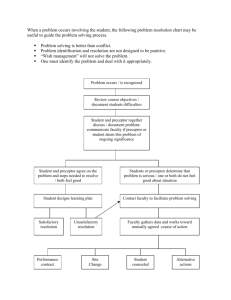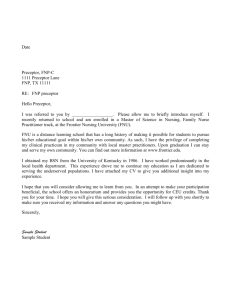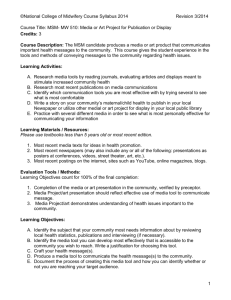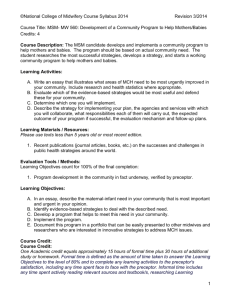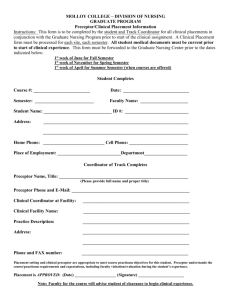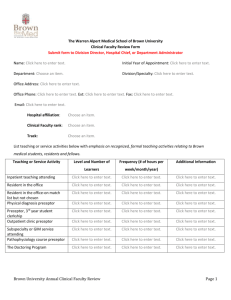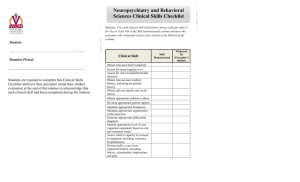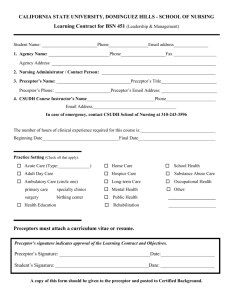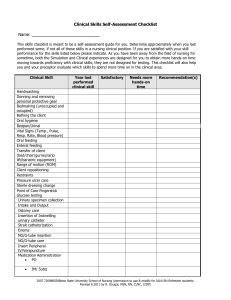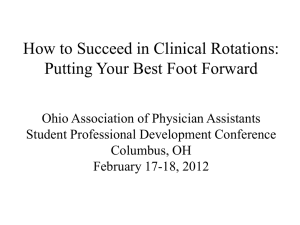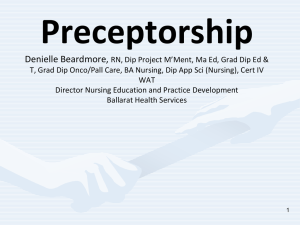preceptor power point - The University of Texas at Brownsville
advertisement
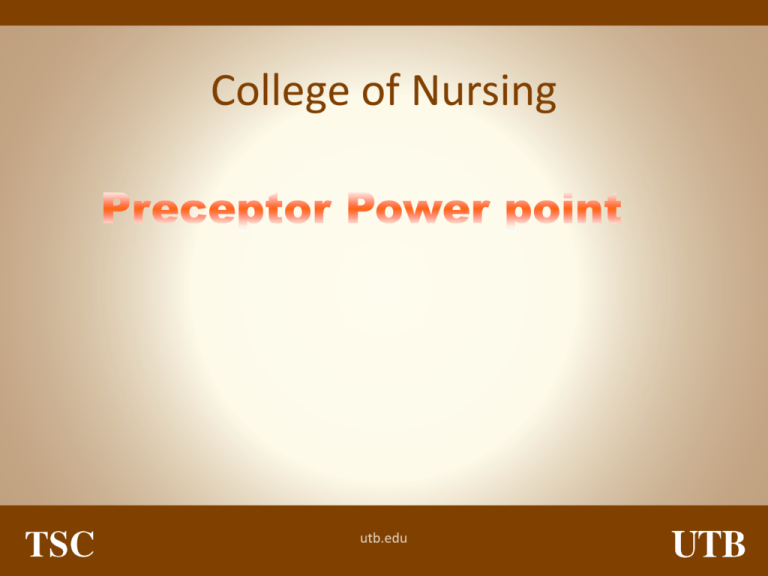
College of Nursing Objectives List preceptor role & responsibilities Describe adults learning styles Explore effective communication, including giving feedback & resolving conflict Discuss techniques for stimulating critical thinking Review components of the UTB CON preceptor handbook Complete preceptor post-test Role of the Preceptor Modeler--demonstrates how competent staff perform their job-most familiar, most comfortable Socializer—integrates student into the unit culture--less familiar, less comfortable &helps student feel welcome Educator—assists student to assess orientation learning needs, plan learning experiences, implement the plan, evaluate performance--least familiar, least comfortable Educator What is a Role Model? Role Model-- “an individual who exemplifies through his or her behavior how a specific role is to be enacted” (JG Alspach, 2000) Nurse role model exhibits these qualities-Caring Positive interactions Empathetic Respected by peers Good communicator Strong patient advocate Expert practitioner Willing resource person Shares knowledge with others Respects dignity in all people Critical thinker Honest, accountable Compare--your usual job activities with teaching others how to perform their job Major Role with Preceptee--teaching rather than doing Conflict--can arise if you “do for” the preceptee rather than guiding to do for themselves Challenge--balancing dual role of caregiver and preceptor Think back to your own orientation-how you felt, new circumstances Reality Shock--4 phases HONEYMOON SHOCK RECOVERY RESOLUTION Adult Learning Principles How Communication is Received Generational Values Learning Styles Self-directed--want to be actively involved Relate new knowledge to life experiences/previous knowledge Goal-oriented Must have a reason for learning Practical--want learning to be useful Want to state their views, be recognized, be accepted, feel important, be respected 60% 30% 10% MATURES--<1946-- “duty” work ethic, follow orders, productive, “fixers” BABY BOOMERS--1946-1964--teamwork, process oriented, desire recognition, uncomfortable with conflict GENERATION Xers--1965-1980--self-reliant, skeptical, casual about authority, tech savvy, resourceful MILLENIALS--1981-1991--tech savvy, less focused on problem solving & more on choices, buy into team concept, look for mentors, accepting of other cultures, expect management to be competent, demand equity Left Brain vs. Right Brain LEFT Analytical Uses automatic codes Arranges details in order Auditory rather than visual RIGHT Global Wholes, not parts Novelty Intuitive Spatial Visual over auditory Goal: To IMPROVE Performance •I…Identify learning objectives •M…Make a feedback-friendly learning environment •P…Performance--assess it •R…Respond to your learner’s self-assessment •O…Objectivity--always keep it •V…Validate good work, suggest alternatives in weak areas •E…Establish a plan • Feedback should be Immediate Clear Positive Objective Task Interdependence Individual Differences Scarce Resources Communication Failures Goal Incompatibility Poorly Designed Reward Systems How to Create Peace Take responsibility Agree to disagree Define the problem Allow venting Establish ground rules--honesty, everyone will be heard, all listen, support feelings with facts Ask open-ended questions Listen objectively Restate problem, set goals, establish action plans Follow-up Improving the Learning Create a climate of curiosity/questioning Environment Ask Open-ended vs. Close-ended questions, qualify answers-correct, partially correct, incorrect Prepare for the unexpected-- “What if…” Think out loud--Verbalize your processes Compare assessment findings with report Reflect on activities/findings of the day Challenge assumptions Seek meanings, connections, group data Keep professional humility--readily admit erroneous conclusions, seek the truth always 1 Plan ahead—tell staff date preceptee is coming to unit, outline daily plans 2 First day—ask your learner to share their goals/needs, share your goals/expectations 3 Introduce to staff—integrate, welcome, include in break times 4 Give specifics about what you expect 5 Get/Give feedback often during the day 6 Reflect on activities, skills completed Identify student’s learning needs—ask for critical skills list, clinical objectives Let student observe what you do, maybe only one client for student care Seek opportunities for student to perform identified highanxiety procedures first—reduces fear, stress Have a brief conference with the student to double-check assessment priorities, medications changes Ask the student to reflect on the day’s activities and discuss situations, ask questions Practice good time management Coach your learner towards excellence in practice Follow NPA delegation guidelines Create opportunities for learning Encourage people to have fun, enjoy their work Move from preceptor to mentor--assist new staff, peers in learning Preceptor Program Preceptor Orientation Information Preceptor Agreement, Benefits Clinical Guidelines Evaluation Tool Student Medication Administration Incident Report Form Student Objectives/Skills Medications --RN must be at bedside with IV “push”administration by student --RN alone can access narcotics, sign narcotics forms for student --RN must supervise student narcotic administration and co-sign MAR Needle sticks/Exposures Student will: --report incident to preceptor immediately and clinical faculty then notify appropriate person in clinical agency --Complete agency incident report --Follow agency protocols regarding wound care, reporting and notify clinical faculty as soon as possible --Seek treatment from Campus Health Center or private provider within 2 hours of incident Freiburger, O. (2001). A tribute to clinical preceptors. Journal for Nurses in Staff Development, Vol. 17, No. 6, 320-327. Alfaro-LeFevre, R. (2002). Improving your ability to think critically. RN, MSN Nursing Spectrum—Career Fitness Online. http://nsweb.nursingspectrum.com/ce168.htm Ohrlin,K. & Hallberg, I. (2000). Student nurses’ lived experience of preceptorship. International Journal of Nursing Studies, 37, 13-23. • You have successfully completed the • University of Texas at Brownsville • College of Nursing • Preceptor Self-Paced Tutorial!
